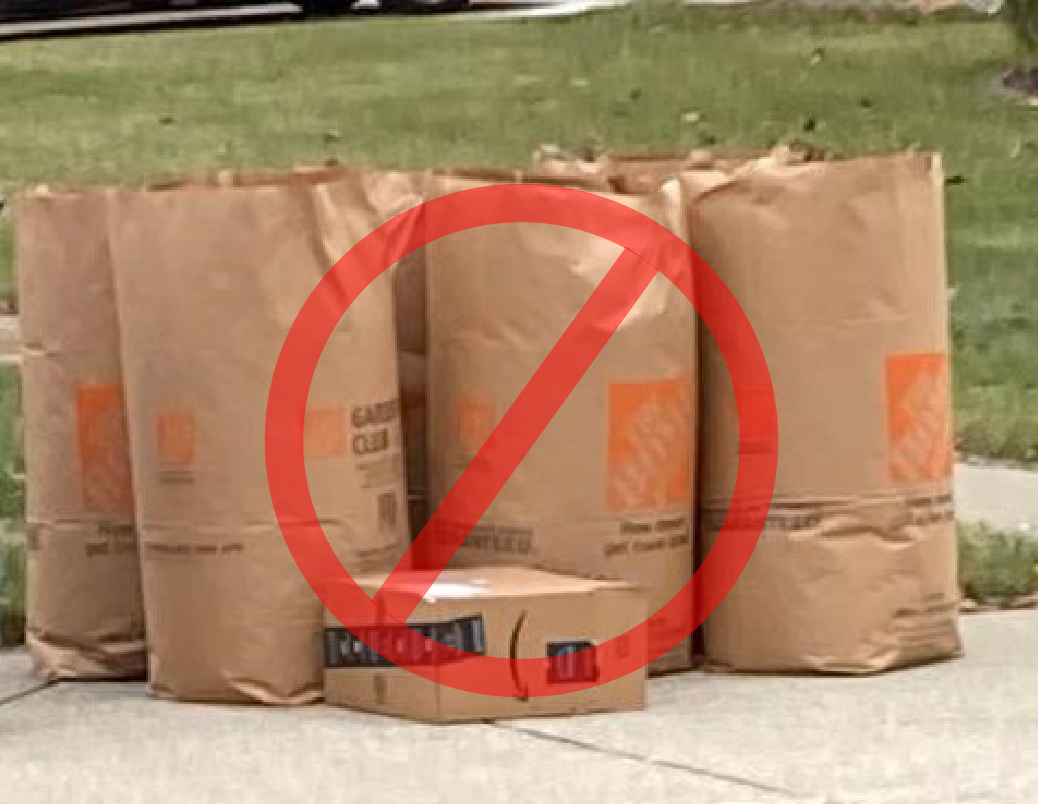‘Leave the Leaves’ has become the battle cry of a growing number of conservation organizations and news outlets.
Certainly, fallen leaves on your property provide critical cover for overwintering insects and other critters. Stuffing leaf bags to make a yard look ‘pristine' creates a dead zone for important pollinators like ground nesting bees.
Besides the negative impact on wildlife, a driveway lined with leaf bags has other environmental consequences. Every year, nearly eight million tons of fallen leaves end up in landfills, according to the National Audubon Society. Even when municipalities compost residents’ leaves, there’s still the gas consumed by the waste trucks hauling off the bags.
That said, the notion of simply ‘Leaving the Leaves’ is problematic. For one, a lawn covered with wet and matted leaves won’t receive light grass needs to photosynthesize. The result: a declining lawn that will likely have numerous dead spots.
And ‘left to their own devices’ leaves will get blown into every nook and cranny along your home, requiring clean up in the spring. Too, leaves that end up on your deck or patio encourage mold growth on those surfaces. Just another chore to add to your spring cleanup list!
Here’s a better idea: Bag the Bags. Doing this can save you time, money and benefit wildlife around your property.
Below are some better options than bagging:
In the spring, the leaf litter has broken down enough to spread around shrubs and over our vegetable beds. I also use it in tandem with our other composting bid, alternating layers of green material (garden and food waste) with the leaf compost. This layered approach helps break down all the material in the bin more quickly.
Think you would have too many leaves to handle even after implementing all of the actions? Before reaching for that leaf bag, consider this: we have two honeysuckles, an oak and a maple (two maples until we had to recently remove one). All mature trees, in addition to about 20 large shrubs. Yet we don’t use more than one or two leaf bags a year. And those are filled with diseased or invasive plant material we don’t compost, as well as leaf litter cleaned up from the street that collects all kinds of nasty residue.
So go ahead: Bag the Bags. You’ll be glad you did.
Certainly, fallen leaves on your property provide critical cover for overwintering insects and other critters. Stuffing leaf bags to make a yard look ‘pristine' creates a dead zone for important pollinators like ground nesting bees.
Besides the negative impact on wildlife, a driveway lined with leaf bags has other environmental consequences. Every year, nearly eight million tons of fallen leaves end up in landfills, according to the National Audubon Society. Even when municipalities compost residents’ leaves, there’s still the gas consumed by the waste trucks hauling off the bags.
That said, the notion of simply ‘Leaving the Leaves’ is problematic. For one, a lawn covered with wet and matted leaves won’t receive light grass needs to photosynthesize. The result: a declining lawn that will likely have numerous dead spots.
And ‘left to their own devices’ leaves will get blown into every nook and cranny along your home, requiring clean up in the spring. Too, leaves that end up on your deck or patio encourage mold growth on those surfaces. Just another chore to add to your spring cleanup list!
Here’s a better idea: Bag the Bags. Doing this can save you time, money and benefit wildlife around your property.
Below are some better options than bagging:
- Simply rake leaves into your planting beds. Help ensure they stay put by raking them further back into your beds nearer to fences or other structures.
- If you have a mulching mower (preferably electric), chop up the leaves as you mow. They will break down quicker while adding key nutrients to your soil such as nitrogen, phosphorous and potassium. It’s best to ‘mow early and often.’ Don’t let leaves pill up too much so it becomes difficult to mow through them. This is especially problematic when leaves get wet. You’ll end up with larger leaf litter that can damage your lawn. To shred leaves into smaller bits, you may have to make multiple passes over the same area.
- Use your mower’s catcher. When the catcher fills up, spread the chopped leaves onto your vegetable and planting beds. Shredded leaves will stay put as they nurture the soil.
- If you are like us and have multiple trees on your property, it may be challenging to find enough places to stash all those leaves—shredded or not. To address this, I built a simple leaf composting bin out of leftover garden fencing and metal stakes. The bin is approximately three feet by three feet and sits in the back corner of our yard next to our garden/food waste composting bin. It’s surprising how much chopped leaf volume the bin holds.
In the spring, the leaf litter has broken down enough to spread around shrubs and over our vegetable beds. I also use it in tandem with our other composting bid, alternating layers of green material (garden and food waste) with the leaf compost. This layered approach helps break down all the material in the bin more quickly.
Think you would have too many leaves to handle even after implementing all of the actions? Before reaching for that leaf bag, consider this: we have two honeysuckles, an oak and a maple (two maples until we had to recently remove one). All mature trees, in addition to about 20 large shrubs. Yet we don’t use more than one or two leaf bags a year. And those are filled with diseased or invasive plant material we don’t compost, as well as leaf litter cleaned up from the street that collects all kinds of nasty residue.
So go ahead: Bag the Bags. You’ll be glad you did.
